Polyalphaolefins Market
Polyalphaolefins Market Size and Share Forecast Outlook 2025 to 2035
Polyalphaolefins market is projected to grow from USD 4.0 billion in 2025 to USD 4.9 billion by 2035, at a CAGR of 2.1%. Medium Viscosity PAO will dominate with a 47.3% market share, while automotive oils will lead the application segment with a 52.8% share.
Polyalphaolefins Market Forecast and Outlook 2025 to 2035
The global polyalphaolefins market is valued at USD 4.0 billion in 2025 and is set to reach USD 4.9 billion by 2035, recording an absolute increase of USD 0.9 billion over the forecast period. This translates into a total growth of 22.5%, with the market forecast to expand at a CAGR of 2.1% between 2025 and 2035.
The overall market size is expected to grow by approximately 1.2 times during the same period, supported by increasing demand for high-performance lubricants, growing automotive production, and rising requirements for energy-efficient fluid solutions across industrial machinery, automotive systems, and specialty applications sectors.
Quick Stats for Polyalphaolefins Market
- Polyalphaolefins Market Value (2025): USD 4.0 billion
- Polyalphaolefins Market Forecast Value (2035): USD 4.9 billion
- Polyalphaolefins Market Forecast CAGR: 2.1%
- Leading Type Category in Polyalphaolefins Market: Medium Viscosity PAO (47.3%)
- Key Growth Regions in Polyalphaolefins Market: Asia Pacific, North America, Europe
- Key Players in Polyalphaolefins Market: Chevron Phillips Chemical, ExxonMobil, INEOS, Fuchs Petrolub, TULSTAR
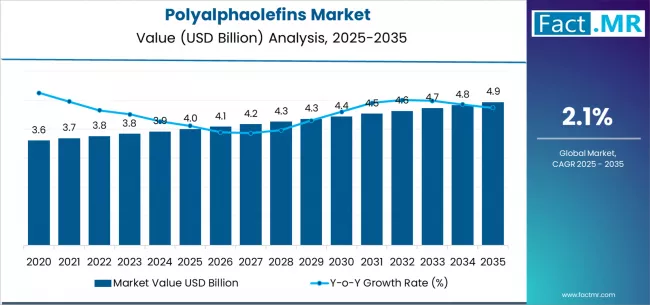
The global market represents a critical segment within the synthetic lubricants and specialty chemicals industry, driven by the superior thermal stability properties of PAO and the exceptional performance characteristics of these synthetic hydrocarbon fluids. These specialized compounds are produced through oligomerization of linear alpha-olefins, providing enhanced viscosity index, oxidation resistance, and low-temperature flow properties for various applications including engine oils, hydraulic fluids, gear lubricants, and compressor oils. The controlled molecular structure eliminates impurities found in conventional mineral oils, making these products particularly suitable for extreme temperature applications and systems requiring extended service intervals.
The market encompasses various viscosity grades, molecular weight ranges, and specialized formulations tailored for specific industrial applications. Modern polyalphaolefins incorporate advanced polymerization technologies, improved catalyst systems, and enhanced purification processes that can deliver consistent molecular structure while maintaining optimal performance characteristics over extended operational periods. The integration of advanced additive packages, enhanced base stock compatibility, and improved manufacturing processes has further enhanced the value proposition of these synthetic fluids among industrial users seeking operational efficiency and equipment protection.
Market dynamics are significantly influenced by stringent automotive emission regulations, particularly in passenger vehicle, commercial transportation, and industrial equipment applications where fuel efficiency improvement and component protection are paramount. The automotive sector's increasing focus on fuel economy, emission reduction, and extended drain intervals has created substantial demand for high-performance synthetic lubricants in engine systems, transmission applications, and hydraulic components. The growing trend toward industrial automation and equipment reliability has amplified the need for premium lubricant systems capable of maintaining performance under severe operating conditions and temperature extremes.
Consumer purchasing patterns show a marked preference for multi-grade lubricant formulations that combine polyalphaolefin base stocks with advanced additive systems, extended service capabilities, and comprehensive performance certifications for diverse automotive and industrial applications. The market has witnessed significant technological advancement in catalyst technology, purification methods, and molecular design optimization, making these products more suitable for extreme pressure, high-temperature, and chemically challenging environments.
Between 2025 and 2030, the market is projected to expand from USD 4.0 billion to USD 4.3 billion, resulting in a value increase of USD 0.3 billion, which represents 33.3% of the total forecast growth for the decade. This phase of development will be shaped by increasing automotive production adoption, rising demand for fuel-efficient lubricant solutions, and growing availability of advanced synthetic base stock systems across automotive manufacturing and industrial machinery applications.
Between 2030 and 2035, the market is forecast to grow from USD 4.3 billion to USD 4.9 billion, adding another USD 0.6 billion, which constitutes 66.7% of the overall ten-year expansion. This period is expected to be characterized by the advancement of bio-based PAO production technologies, the development of ultra-high viscosity index formulations for specialized applications, and the expansion of synthetic lubricant adoption across diverse automotive and industrial equipment applications. The growing focus on equipment longevity and operational optimization will drive demand for advanced polyalphaolefin varieties with enhanced thermal stability capabilities, improved low-temperature performance characteristics, and superior oxidation resistance profiles.
Between 2020 and 2024, the market experienced steady growth, driven by increasing automotive industry investments and growing recognition of synthetic lubricants' superior performance in fuel economy improvement following extensive OEM adoption campaigns. The market developed as manufacturers recognized the advantages of PAO-based lubricants over conventional mineral oils in demanding applications and began seeking specialized solutions designed for extended drain intervals and severe service requirements. Technological advancement in catalyst systems and purification technologies began emphasizing the critical importance of maintaining molecular uniformity while enhancing thermal stability and improving service life across diverse automotive and industrial lubricant applications.
Polyalphaolefins Market Key Takeaways
| Metric | Value |
|---|---|
| Estimated Value in (2025E) | USD 4.0 billion |
| Forecast Value in (2035F) | USD 4.9 billion |
| Forecast CAGR (2025 to 2035) | 2.1% |
From 2030 to 2035, the market is forecast to grow from USD 4.3 billion to USD 4.9 billion, adding another USD 0.6 billion, which constitutes 66.7% of the overall ten-year expansion. This period is expected to be characterized by the advancement of artificial intelligence integration in production optimization systems, the integration of predictive quality control for optimal manufacturing efficiency, and the development of specialized PAO grades for high-performance automotive applications. The growing focus on fuel efficiency and equipment protection will drive demand for premium varieties with enhanced viscosity index capabilities, improved additive compatibility, and superior thermal stability characteristics.
Between 2020 and 2024, the market experienced robust growth, driven by increasing awareness of lubricant-related maintenance costs and growing recognition of specialized synthetic base stocks' effectiveness in supporting reliable equipment operation across automotive platforms and industrial machinery applications. The market developed as users recognized the potential for polyalphaolefin-based lubricants to deliver operational advantages while meeting modern requirements for fuel economy improvement and reliable equipment protection. Technological advancement in polymerization control and molecular weight optimization began emphasizing the critical importance of maintaining performance consistency while extending service intervals and improving user satisfaction across diverse automotive and industrial lubricant applications.
Why is the Polyalphaolefins Market Growing?
Market expansion is being supported by the increasing global focus on automotive fuel efficiency and the corresponding shift toward high-performance synthetic lubricants that can provide superior thermal stability characteristics while meeting user requirements for extended service intervals and cost-effective maintenance solutions. Modern automotive and industrial users are increasingly focused on incorporating lubricant systems that can enhance equipment protection while satisfying demands for consistent, precisely controlled viscosity performance and optimized fuel consumption practices. Polyalphaolefins' proven ability to deliver thermal stability excellence, oxidation resistance benefits, and diverse application possibilities makes them essential components for efficiency-focused manufacturers and quality-focused automotive professionals.
The growing focus on equipment longevity and industrial machinery reliability is driving demand for high-performance synthetic base stocks that can support distinctive operational outcomes and comprehensive lubrication management across automotive engines, hydraulic systems, and premium industrial installations. User preference for lubricant solutions that combine functional excellence with extended service capability is creating opportunities for innovative implementations in both traditional and emerging automotive and industrial applications. The rising influence of emission regulations and advanced engine technologies is also contributing to increased adoption of synthetic lubricant solutions that can provide authentic fuel economy benefits and reliable performance characteristics.
Segmental Analysis
What factors enable the medium viscosity PAO type and automotive oils application segments to lead market share and demonstrate strong dominance?
The market is segmented by type, application, end use, grade, and region. By type, the market is divided into low viscosity PAO, medium viscosity PAO, and high viscosity PAO. Based on application, the market is categorized into automotive oils, industrial lubricants, hydraulic fluids, compressor oils, and others. By end use, the market includes automotive, industrial machinery, aerospace, marine, and others. By grade, the market encompasses standard grade, premium grade, and specialty grade. By region, the market is divided into North America, Europe, Asia Pacific, Latin America, Middle East & Africa, and other regions.
By Type, the Medium Viscosity PAO Segment Accounts for 47.3% Market Share
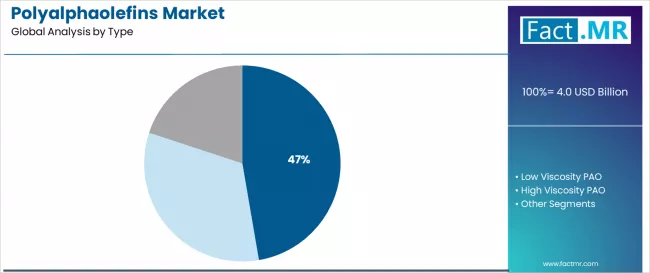
The medium viscosity PAO segment is projected to account for 47.3% of the market in 2025, reaffirming its position as the leading type category. Industrial users and automotive professionals increasingly utilize medium viscosity systems for their superior lubrication characteristics, established performance standards, and essential functionality in diverse engine oil and hydraulic fluid applications across multiple automotive and industrial sectors. Medium viscosity PAO's proven performance characteristics and established cost-effectiveness directly address user requirements for reliable lubrication and optimal operational precision in automotive and industrial machinery applications.
This type segment forms the foundation of modern lubricant performance patterns, as it represents the viscosity grade with the greatest application versatility and established compatibility across multiple automotive and industrial lubrication systems. Industrial investments in advanced base stock technology and performance optimization continue to strengthen adoption among efficiency-focused users. With manufacturers prioritizing operational consistency and protection reliability, medium viscosity systems align with both performance objectives and cost requirements, making them the central component of comprehensive lubrication strategies.
By Application, Automotive Oils Segment Shows Strong Market Dominance
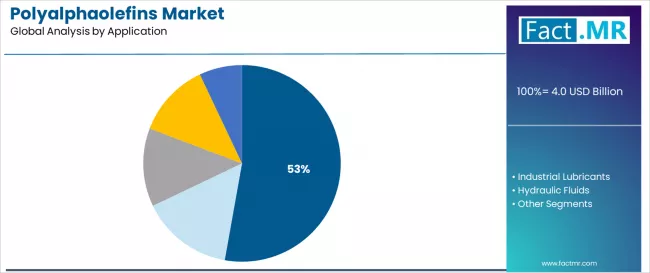
Automotive oils are projected to represent 52.8% of the market in 2025, highlighting its critical role as the primary application for efficiency-focused users seeking superior lubrication benefits and enhanced engine performance credentials. Automotive users and fleet operators prefer automotive oil applications for their established operational requirements, proven performance demand, and ability to maintain exceptional protection precision while supporting versatile engine coverage during diverse driving conditions. Positioned as essential applications for efficiency-focused manufacturers, automotive oil offerings provide both operational excellence and fuel economy advantages.
The segment is supported by continuous improvement in engine technology and the widespread availability of established automotive standards that enable performance assurance and premium positioning at the OEM level. Automotive users are optimizing lubricant selections to support engine-specific applications and comprehensive vehicle maintenance strategies. As emission regulations continue to advance and manufacturers seek efficient lubrication methods, automotive oil applications will continue to drive market growth while supporting fuel efficiency and engine protection strategies.
What are the Drivers, Restraints, and Key Trends of the Polyalphaolefins Market?
The polyalphaolefins market is advancing rapidly due to increasing automotive fuel efficiency requirements and growing need for high-performance synthetic lubricants that emphasize superior thermal stability across automotive segments and industrial machinery applications. The market faces challenges, including competition from alternative synthetic base stocks, raw material price volatility, and initial cost considerations affecting adoption rates. Innovation in catalyst technology enhancement and advanced purification methods continues to influence market development and expansion patterns.
Expansion of Electric Vehicle and Hybrid Applications
The growing adoption of polyalphaolefins in electric vehicle transmission systems and hybrid powertrain applications is enabling users to develop lubrication strategies that provide distinctive thermal management benefits while commanding extended service intervals and enhanced component protection characteristics. Electric and hybrid vehicle applications provide superior operational consistency while allowing more sophisticated thermal management features across various automotive categories. Users are increasingly recognizing the operational advantages of synthetic base stocks for comprehensive component protection outcomes and technology-integrated automotive management.
Integration of Advanced Additive Compatibility Systems
Modern polyalphaolefin manufacturers are incorporating enhanced additive solubility characteristics, improved compatibility with performance additives, and advanced formulation flexibility to enhance lubricant performance, improve equipment protection effectiveness, and meet automotive demands for extended drain interval solutions. These systems improve operational effectiveness while enabling new applications, including high-temperature operation programs and specialized equipment protocols. Advanced compatibility integration also allows users to support premium positioning and performance assurance beyond traditional lubricant operation requirements.
Analysis of the Polyalphaolefins Market by Key Country
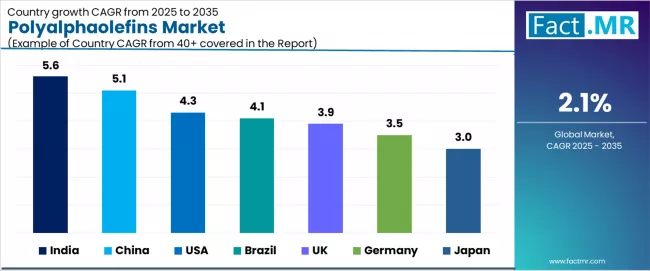
| Country | CAGR (2025-2035) |
|---|---|
| China | 5.1% |
| India | 5.6% |
| Germany | 3.5% |
| Brazil | 4.1% |
| USA | 4.3% |
| UK | 3.9% |
| Japan | 3.0% |
The market is experiencing robust growth globally, with India leading at a 5.6% CAGR through 2035, driven by the expanding automotive manufacturing sector, growing industrial machinery requirements, and increasing adoption of advanced synthetic lubricant systems. China follows at 5.1%, supported by rising automotive production, expanding manufacturing industry, and growing acceptance of high-performance lubrication technologies. The USA shows growth at 4.3%, emphasizing established automotive standards and comprehensive industrial machinery development. Brazil records 4.1%, focusing on automotive sector modernization and industrial efficiency growth. Germany demonstrates 3.5% growth, prioritizing advanced automotive technologies and operational optimization.
The report covers an in-depth analysis of 40+ countries, top-performing countries are highlighted below.
Why does India lead global market growth through an automotive manufacturing revolution?
India is projected to exhibit exceptional growth with a CAGR of 5.6% through 2035, driven by the country's rapidly expanding automotive manufacturing sector, favorable government policies toward industrial modernization, and initiatives promoting advanced lubrication technologies across major automotive production regions. India's position as an emerging automotive hub and increasing focus on fuel efficiency systems are creating substantial demand for high-quality synthetic base stocks in both domestic and export markets. Major automotive companies and lubricant distributors are establishing comprehensive PAO capabilities to serve growing demand and emerging automotive opportunities.
- Established automotive culture and expanding fuel efficiency consciousness are driving demand for polyalphaolefins across automotive facilities, industrial plants, and comprehensive lubrication systems throughout Indian automotive markets.
- Strong manufacturing infrastructure and technology adoption initiatives are supporting the rapid adoption of premium synthetic base stocks among efficiency-focused manufacturers seeking to meet evolving automotive standards and performance requirements.
How does China demonstrate strong market potential through an industrial development focus?
China is expanding at a CAGR of 5.1%, supported by rising automotive production investment, growing lubrication consciousness, and expanding equipment distributor capabilities. The country's developing automotive infrastructure and increasing investment in manufacturing technologies are driving demand for synthetic base stocks across both traditional and modern automotive applications. International lubricant companies and domestic distributors are establishing comprehensive operational networks to address growing market demand for high-performance lubricants and efficient automotive solutions.
- Rising automotive development and expanding manufacturing capabilities are creating opportunities for polyalphaolefin adoption across automotive industries, modern manufacturing projects, and distributor companies throughout major Chinese industrial regions.
- Growing efficiency awareness initiatives and lubrication technology advancement are driving the adoption of specialized synthetic products and services among automotive users seeking to enhance their operational efficiency and meet increasing performance demand.
How does the USA maintain market leadership through automotive excellence?
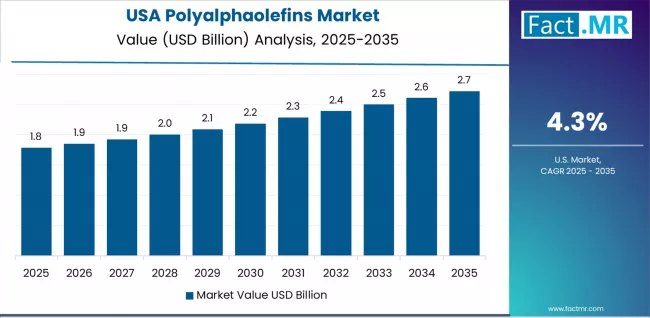
The USA is projected to grow at a CAGR of 4.3% through 2035, supported by the country's mature automotive standards, established fuel efficiency regulations, and leadership in synthetic lubricant technology. The USA's sophisticated automotive standards and strong support for advanced lubrication systems are creating steady demand for both traditional and innovative polyalphaolefin varieties. Leading automotive manufacturers and specialty distributors are establishing comprehensive operational strategies to serve both domestic markets and growing export opportunities.
- Advanced automotive technology capabilities and established efficiency-focused markets are driving demand for premium polyalphaolefins across automotive facilities, industrial plants, and comprehensive lubrication companies seeking superior performance profiles and automotive innovation.
- Strong automotive excellence culture and regulatory leadership are supporting the adoption of innovative synthetic technology among users prioritizing operational reliability and automotive precision in lubrication applications.
How does Brazil strengthen its position through automotive modernization growth?
Brazil is projected to grow at a CAGR of 4.1% through 2035, driven by the country's focus on automotive development, manufacturing modernization growth, and growing lubrication distributor capabilities. Brazilian automotive users and manufacturing facilities consistently seek efficiency-focused lubricants that enhance operational performance and support modernization excellence for both traditional and modern automotive applications. The country's position as a Latin American automotive leader continues to drive innovation in specialized lubrication applications and automotive efficiency standards.
- Expanding automotive culture and growing industrial markets are driving demand for industrial polyalphaolefins across automotive consumers, efficiency providers, and performance-focused distributors seeking superior lubrication and distinctive operational profiles.
- Increasing focus on automotive efficiency and manufacturing modernization systems is supporting the adoption of specialty synthetic varieties among users and distributors seeking authentic Brazilian efficiency-focused products in regional markets with established automotive expertise.
How does the UK anchor market growth through technology integration?
The UK is projected to grow at a CAGR of 3.9% through 2035, supported by the country's focus on automotive technology advancement, industrial lubrication optimization, and advanced synthetic system integration requiring efficient lubricant solutions. British automotive users and efficiency-focused facilities prioritize performance reliability and operational precision, making specialized polyalphaolefins essential components for both traditional and modern automotive lubrication applications. The country's comprehensive automotive technology leadership and advancing efficiency patterns support continued market expansion.
- Advanced automotive technology capabilities and growing precision lubrication management are driving demand for polyalphaolefins across specialty applications, modern automotive formats, and technology-integrated efficiency programs serving domestic markets with increasing operational requirements.
- Strong focus on operational optimization and performance excellence is encouraging users and distributors to adopt synthetic solutions that support efficiency objectives and meet British quality standards for automotive lubrication applications.
How does Germany maintain steady growth through a focus on automotive reliability?
Germany is projected to grow at a CAGR of 3.5% through 2035, supported by established automotive standards, mature lubrication markets, and focus on operational reliability across automotive and industrial sectors. German automotive users and lubrication professionals prioritize quality performance and operational consistency, creating steady demand for premium synthetic solutions. The country's comprehensive market maturity and established automotive practices support continued development in specialized applications.
- Established automotive markets and mature lubrication industry are driving demand for quality polyalphaolefins across automotive operations, industrial facilities, and professional lubrication companies throughout German automotive regions.
- Strong focus on quality standards and operational reliability is supporting the adoption of premium synthetic varieties among users seeking proven performance and established automotive credentials in lubrication applications.
How does Japan demonstrate growth through a focus on precision?
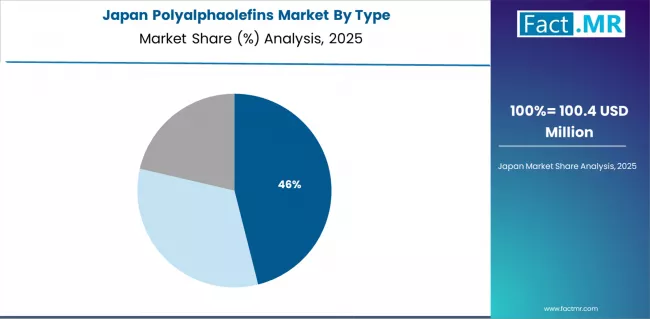
Japan is projected to grow at a CAGR of 3.0% through 2035, supported by the country's focus on precision automotive manufacturing, operational excellence, and advanced technology integration requiring efficient lubricant solutions. Japanese automotive users and efficiency-focused facilities prioritize technical performance and manufacturing precision, making specialized polyalphaolefins essential components for both traditional and modern automotive lubrication applications. The country's comprehensive automotive leadership and advancing precision patterns support continued market expansion.
- Advanced precision automotive technology capabilities and growing technical lubrication applications are driving demand for polyalphaolefins across specialty automotive applications, modern precision formats, and technology-integrated manufacturing programs serving domestic markets with increasing quality requirements.
- Strong focus on technical precision and operational excellence is encouraging users and distributors to adopt synthetic solutions that support automotive objectives and meet Japanese precision standards for lubrication applications.
Europe Market Split by Country
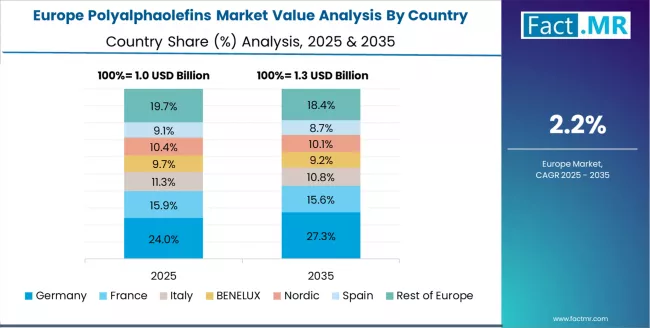
The Europe polyalphaolefins market is projected to grow from USD 1.1 billion in 2025 to USD 1.3 billion by 2035, recording a CAGR of 2.0% over the forecast period. Germany leads the region with a 38.7% share in 2025, moderating slightly to 37.9% by 2035, supported by its strong automotive traditions and demand for premium, high-performance synthetic lubricant solutions. The United Kingdom follows with 22.4% in 2025, easing to 21.8% by 2035, driven by a mature automotive market and focus on operational reliability and quality performance. France accounts for 16.2% in 2025, rising to 16.7% by 2035, reflecting steady adoption of automotive efficiency technologies and lubrication optimization. Italy holds 10.8% in 2025, expanding to 11.4% by 2035 as automotive modernization and specialty lubrication applications grow. Spain contributes 6.3% in 2025, growing to 6.8% by 2035, supported by expanding automotive development and efficiency awareness modernization. The Nordic countries rise from 3.4% in 2025 to 3.6% by 2035 on the back of strong automotive consciousness and advanced manufacturing methodologies. BENELUX remains at 2.2% share across both 2025 and 2035, reflecting mature, efficiency-focused automotive markets.
How is the competitive landscape of the polyalphaolefins market structured and what key factors shape competition?
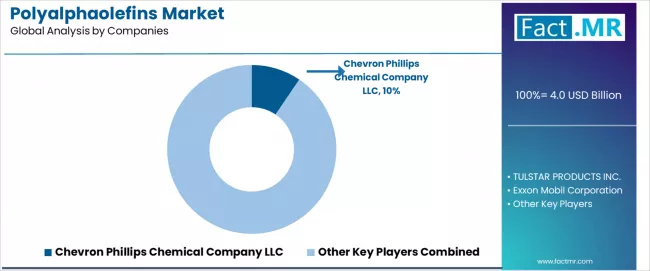
The market is characterized by competition among established chemical manufacturers, specialized synthetic base stock companies, and integrated lubricant providers. Companies are investing in advanced polymerization technologies, specialized catalyst systems, product innovation capabilities, and comprehensive distribution networks to deliver consistent, high-quality, and reliable synthetic base stock systems. Innovation in molecular weight optimization, purification technology advancement, and automotive-focused product development is central to strengthening market position and customer satisfaction.
Chevron Phillips Chemical Company leads the market with a strong focus on synthetic chemistry innovation and comprehensive base stock solutions, offering automotive and industrial systems with focus on performance excellence and chemical engineering heritage. ExxonMobil provides integrated petrochemical production with a focus on automotive market applications and precision lubrication networks. INEOS delivers comprehensive synthetic technology solutions with a focus on industrial positioning and operational efficiency. Fuchs Petrolub specializes in comprehensive lubricant systems with a focus on automotive applications. TULSTAR focuses on comprehensive specialty chemicals with advanced design and premium positioning capabilities.
Global Polyalphaolefins Market - Stakeholder Contribution Framework
The success of polyalphaolefins in meeting automotive efficiency demands, industrial lubrication requirements, and operational integration will not only enhance automotive performance outcomes but also strengthen global synthetic lubricant manufacturing capabilities. It will consolidate emerging regions' positions as hubs for efficient synthetic base stock production and align advanced economies with comprehensive lubrication systems. This calls for a concerted effort by all stakeholders - governments, industry bodies, manufacturers, distributors, and investors. Each can be a crucial enabler in preparing the market for its next phase of growth.
How Governments Could Spur Local Production and Adoption?
- Targeted Incentives: Introduce automotive efficiency modernization subsidies for companies adopting advanced synthetic base stock production technologies in automotive and industrial regions, and production-linked incentives for facilities producing chemicals for domestic consumption and export markets.
- Trade Agreements: Accelerate export growth through bilateral and multilateral agreements that classify polyalphaolefins under "automotive chemicals," easing cross-border regulatory approvals and automotive safety certifications.
- Facilitate Innovation: Establish Centers of Excellence for synthetic chemistry innovation and lubricant engineering. Fund R&D into efficient polymerization systems, catalyst optimization, and automotive-standard integration for manufacturing and lubrication applications.
How Industry Bodies Could Support Market Development?
- Foster Connectivity: Constitute a global synthetic chemistry consortium linking base stock manufacturers, automotive lubricant suppliers, users, and policymakers to align production targets with automotive efficiency and performance commitments.
- Promote Exports: Work with export councils to brand polyalphaolefins as premium, engineering-focused synthetic solutions. Facilitate trade fairs to connect synthetic chemistry innovators with global buyers in automotive, industrial, and lubrication sectors.
- Upskilling Programs: Develop curricula on advanced synthetic manufacturing, polymerization technology, automotive lubrication processes, and efficiency optimization to prepare manufacturers and operators for premium automotive market opportunities.
How Distributors and Automotive Lubrication Players Could Strengthen the Ecosystem?
- Drive Integration: Bundle polyalphaolefins with efficiency-focused marketing and performance messaging systems. Position specialized synthetic base stocks as part of holistic "automotive lubrication optimization solutions."
- Forge Partnerships: Collaborate with base stock manufacturers and technology providers for joint R&D on automotive applications, efficiency enhancement initiatives, and global quality assurance for premium markets.
How Manufacturers Could Navigate the Shift?
- Capture Premium Markets: Leverage government incentives and rising efficiency demand to offer polyalphaolefins into growth markets where general synthetic solutions face performance and reliability challenges.
- Invest in Technology: Partner with technology providers to advance efficient polymerization workflows, automotive-grade quality, and advanced manufacturing practices.
- Build Capabilities: Train technical staff and lubrication specialists to demonstrate polyalphaolefins' operational advantages, repositioning automotive relationships toward long-term efficiency partnerships.
Key Players in the Polyalphaolefins Market
- Chevron Phillips Chemical Company LLC
- TULSTAR PRODUCTS INC.
- Exxon Mobil Corporation
- Ineos Group Ltd.
- Lubricon Industries
- RB PRODUCTS, Inc.
- Shanghai NACO Lubrication Co., Ltd.
- Fuchs Petrolub SE
- Lanxess AG
- Idemitsu Kosan Co., Ltd.
- Chemtura Corporation
- Dow Chemical Company
- Shell Global Solutions
- TotalEnergies SE
- Castrol Limited
- Mobil 1
- Valvoline Inc.
- Pennzoil Products Company
- AMSOIL INC.
- Red Line Synthetic Oil Corporation
- Royal Purple LLC
- Motul SA
Scope of the Report
| Items | Values |
|---|---|
| Quantitative Units (2025) | USD 4.0 billion |
| Type | Low Viscosity PAO, Medium Viscosity PAO, High Viscosity PAO |
| Application | Automotive Oils, Industrial Lubricants, Hydraulic Fluids, Compressor Oils, Others |
| End Use | Automotive, Industrial Machinery, Aerospace, Marine, Others |
| Grade | Standard Grade, Premium Grade, Specialty Grade |
| Regions Covered | North America, Europe, Asia Pacific, Latin America, Middle East & Africa, Other Regions |
| Countries Covered | China, India, Germany, Brazil, United States, United Kingdom, Japan, and 40+ countries |
| Key Companies Profiled | Chevron Phillips Chemical, ExxonMobil, INEOS, Fuchs Petrolub, TULSTAR, and other leading polyalphaolefin companies |
| Additional Attributes | Dollar sales by type, application, end use, grade, and region; regional demand trends, competitive landscape, technological advancements in synthetic chemistry, polymerization optimization initiatives, automotive enhancement programs, and premium product development strategies |
Polyalphaolefins Market by Segments
-
Type :
- Low Viscosity PAO
- Medium Viscosity PAO
- High Viscosity PAO
-
Application :
- Automotive Oils
- Industrial Lubricants
- Hydraulic Fluids
- Compressor Oils
- Others
-
End Use :
- Automotive
- Industrial Machinery
- Aerospace
- Marine
- Others
-
Grade :
- Standard Grade
- Premium Grade
- Specialty Grade
-
Region :
- North America
- United States
- Canada
- Mexico
- Europe
- Germany
- United Kingdom
- France
- Italy
- Spain
- Nordic Countries
- BENELUX
- Rest of Europe
- Asia Pacific
- China
- India
- Japan
- South Korea
- Australia
- Rest of Asia Pacific
- Latin America
- Brazil
- Argentina
- Rest of Latin America
- Middle East & Africa
- Kingdom of Saudi Arabia
- United Arab Emirates
- South Africa
- Rest of Middle East & Africa
- Other Regions
- Oceania
- Central Asia
- Other Markets
- North America
Table of Content
- Executive Summary
- Global Market Outlook
- Demand to side Trends
- Supply to side Trends
- Technology Roadmap Analysis
- Analysis and Recommendations
- Market Overview
- Market Coverage / Taxonomy
- Market Definition / Scope / Limitations
- Market Background
- Market Dynamics
- Drivers
- Restraints
- Opportunity
- Trends
- Scenario Forecast
- Demand in Optimistic Scenario
- Demand in Likely Scenario
- Demand in Conservative Scenario
- Opportunity Map Analysis
- Product Life Cycle Analysis
- Supply Chain Analysis
- Investment Feasibility Matrix
- Value Chain Analysis
- PESTLE and Porter’s Analysis
- Regulatory Landscape
- Regional Parent Market Outlook
- Production and Consumption Statistics
- Import and Export Statistics
- Market Dynamics
- Global Market Analysis 2020 to 2024 and Forecast, 2025 to 2035
- Historical Market Size Value (USD Million) Analysis, 2020 to 2024
- Current and Future Market Size Value (USD Million) Projections, 2025 to 2035
- Y to o to Y Growth Trend Analysis
- Absolute $ Opportunity Analysis
- Global Market Pricing Analysis 2020 to 2024 and Forecast 2025 to 2035
- Global Market Analysis 2020 to 2024 and Forecast 2025 to 2035, By Type
- Introduction / Key Findings
- Historical Market Size Value (USD Million) Analysis By Type , 2020 to 2024
- Current and Future Market Size Value (USD Million) Analysis and Forecast By Type , 2025 to 2035
- Medium Viscosity PAO
- Low Viscosity PAO
- High Viscosity PAO
- Y to o to Y Growth Trend Analysis By Type , 2020 to 2024
- Absolute $ Opportunity Analysis By Type , 2025 to 2035
- Global Market Analysis 2020 to 2024 and Forecast 2025 to 2035, By Application
- Introduction / Key Findings
- Historical Market Size Value (USD Million) Analysis By Application, 2020 to 2024
- Current and Future Market Size Value (USD Million) Analysis and Forecast By Application, 2025 to 2035
- Automotive Oils
- Industrial Lubricants
- Hydraulic Fluids
- Compressor Oils
- Others
- Y to o to Y Growth Trend Analysis By Application, 2020 to 2024
- Absolute $ Opportunity Analysis By Application, 2025 to 2035
- Global Market Analysis 2020 to 2024 and Forecast 2025 to 2035, By Region
- Introduction
- Historical Market Size Value (USD Million) Analysis By Region, 2020 to 2024
- Current Market Size Value (USD Million) Analysis and Forecast By Region, 2025 to 2035
- North America
- Latin America
- Western Europe
- Eastern Europe
- East Asia
- South Asia and Pacific
- Middle East & Africa
- Market Attractiveness Analysis By Region
- North America Market Analysis 2020 to 2024 and Forecast 2025 to 2035, By Country
- Historical Market Size Value (USD Million) Trend Analysis By Market Taxonomy, 2020 to 2024
- Market Size Value (USD Million) Forecast By Market Taxonomy, 2025 to 2035
- By Country
- USA
- Canada
- Mexico
- By Type
- By Application
- By Country
- Market Attractiveness Analysis
- By Country
- By Type
- By Application
- Key Takeaways
- Latin America Market Analysis 2020 to 2024 and Forecast 2025 to 2035, By Country
- Historical Market Size Value (USD Million) Trend Analysis By Market Taxonomy, 2020 to 2024
- Market Size Value (USD Million) Forecast By Market Taxonomy, 2025 to 2035
- By Country
- Brazil
- Chile
- Rest of Latin America
- By Type
- By Application
- By Country
- Market Attractiveness Analysis
- By Country
- By Type
- By Application
- Key Takeaways
- Western Europe Market Analysis 2020 to 2024 and Forecast 2025 to 2035, By Country
- Historical Market Size Value (USD Million) Trend Analysis By Market Taxonomy, 2020 to 2024
- Market Size Value (USD Million) Forecast By Market Taxonomy, 2025 to 2035
- By Country
- Germany
- UK
- Italy
- Spain
- France
- Nordic
- BENELUX
- Rest of Western Europe
- By Type
- By Application
- By Country
- Market Attractiveness Analysis
- By Country
- By Type
- By Application
- Key Takeaways
- Eastern Europe Market Analysis 2020 to 2024 and Forecast 2025 to 2035, By Country
- Historical Market Size Value (USD Million) Trend Analysis By Market Taxonomy, 2020 to 2024
- Market Size Value (USD Million) Forecast By Market Taxonomy, 2025 to 2035
- By Country
- Russia
- Poland
- Hungary
- Balkan & Baltic
- Rest of Eastern Europe
- By Type
- By Application
- By Country
- Market Attractiveness Analysis
- By Country
- By Type
- By Application
- Key Takeaways
- East Asia Market Analysis 2020 to 2024 and Forecast 2025 to 2035, By Country
- Historical Market Size Value (USD Million) Trend Analysis By Market Taxonomy, 2020 to 2024
- Market Size Value (USD Million) Forecast By Market Taxonomy, 2025 to 2035
- By Country
- China
- Japan
- South Korea
- By Type
- By Application
- By Country
- Market Attractiveness Analysis
- By Country
- By Type
- By Application
- Key Takeaways
- South Asia and Pacific Market Analysis 2020 to 2024 and Forecast 2025 to 2035, By Country
- Historical Market Size Value (USD Million) Trend Analysis By Market Taxonomy, 2020 to 2024
- Market Size Value (USD Million) Forecast By Market Taxonomy, 2025 to 2035
- By Country
- India
- ASEAN
- Australia & New Zealand
- Rest of South Asia and Pacific
- By Type
- By Application
- By Country
- Market Attractiveness Analysis
- By Country
- By Type
- By Application
- Key Takeaways
- Middle East & Africa Market Analysis 2020 to 2024 and Forecast 2025 to 2035, By Country
- Historical Market Size Value (USD Million) Trend Analysis By Market Taxonomy, 2020 to 2024
- Market Size Value (USD Million) Forecast By Market Taxonomy, 2025 to 2035
- By Country
- Kingdom of Saudi Arabia
- Other GCC Countries
- Turkiye
- South Africa
- Other African Union
- Rest of Middle East & Africa
- By Type
- By Application
- By Country
- Market Attractiveness Analysis
- By Country
- By Type
- By Application
- Key Takeaways
- Key Countries Market Analysis
- USA
- Pricing Analysis
- Market Share Analysis, 2024
- By Type
- By Application
- Canada
- Pricing Analysis
- Market Share Analysis, 2024
- By Type
- By Application
- Mexico
- Pricing Analysis
- Market Share Analysis, 2024
- By Type
- By Application
- Brazil
- Pricing Analysis
- Market Share Analysis, 2024
- By Type
- By Application
- Chile
- Pricing Analysis
- Market Share Analysis, 2024
- By Type
- By Application
- Germany
- Pricing Analysis
- Market Share Analysis, 2024
- By Type
- By Application
- UK
- Pricing Analysis
- Market Share Analysis, 2024
- By Type
- By Application
- Italy
- Pricing Analysis
- Market Share Analysis, 2024
- By Type
- By Application
- Spain
- Pricing Analysis
- Market Share Analysis, 2024
- By Type
- By Application
- France
- Pricing Analysis
- Market Share Analysis, 2024
- By Type
- By Application
- India
- Pricing Analysis
- Market Share Analysis, 2024
- By Type
- By Application
- ASEAN
- Pricing Analysis
- Market Share Analysis, 2024
- By Type
- By Application
- Australia & New Zealand
- Pricing Analysis
- Market Share Analysis, 2024
- By Type
- By Application
- China
- Pricing Analysis
- Market Share Analysis, 2024
- By Type
- By Application
- Japan
- Pricing Analysis
- Market Share Analysis, 2024
- By Type
- By Application
- South Korea
- Pricing Analysis
- Market Share Analysis, 2024
- By Type
- By Application
- Russia
- Pricing Analysis
- Market Share Analysis, 2024
- By Type
- By Application
- Poland
- Pricing Analysis
- Market Share Analysis, 2024
- By Type
- By Application
- Hungary
- Pricing Analysis
- Market Share Analysis, 2024
- By Type
- By Application
- Kingdom of Saudi Arabia
- Pricing Analysis
- Market Share Analysis, 2024
- By Type
- By Application
- Turkiye
- Pricing Analysis
- Market Share Analysis, 2024
- By Type
- By Application
- South Africa
- Pricing Analysis
- Market Share Analysis, 2024
- By Type
- By Application
- USA
- Market Structure Analysis
- Competition Dashboard
- Competition Benchmarking
- Market Share Analysis of Top Players
- By Regional
- By Type
- By Application
- Competition Analysis
- Competition Deep Dive
- Chevron Phillips Chemical Company LLC
- Overview
- Product Portfolio
- Profitability by Market Segments (Product/Age /Sales Channel/Region)
- Sales Footprint
- Strategy Overview
- Marketing Strategy
- Product Strategy
- Channel Strategy
- TULSTAR PRODUCTS INC.
- Exxon Mobil Corporation
- Ineos Group Ltd.
- Lubricon Industries
- RB PRODUCTS, Inc.
- Shanghai NACO Lubrication Co., Ltd.
- Fuchs Petrolub SE
- Lanxess AG
- Idemitsu Kosan Co., Ltd.
- Chemtura Corporation
- Dow Chemical Company
- Shell Global Solutions
- TotalEnergies SE
- Castrol Limited
- Mobil 1
- Valvoline Inc.
- Pennzoil Products Company
- AMSOIL INC.
- Red Line Synthetic Oil Corporation
- Chevron Phillips Chemical Company LLC
- Competition Deep Dive
- Assumptions & Acronyms Used
- Research Methodology
List Of Table
- Table 1: Global Market Value (USD Million) Forecast by Region, 2020 to 2035
- Table 2: Global Market Value (USD Million) Forecast by Type , 2020 to 2035
- Table 3: Global Market Value (USD Million) Forecast by Application, 2020 to 2035
- Table 4: North America Market Value (USD Million) Forecast by Country, 2020 to 2035
- Table 5: North America Market Value (USD Million) Forecast by Type , 2020 to 2035
- Table 6: North America Market Value (USD Million) Forecast by Application, 2020 to 2035
- Table 7: Latin America Market Value (USD Million) Forecast by Country, 2020 to 2035
- Table 8: Latin America Market Value (USD Million) Forecast by Type , 2020 to 2035
- Table 9: Latin America Market Value (USD Million) Forecast by Application, 2020 to 2035
- Table 10: Western Europe Market Value (USD Million) Forecast by Country, 2020 to 2035
- Table 11: Western Europe Market Value (USD Million) Forecast by Type , 2020 to 2035
- Table 12: Western Europe Market Value (USD Million) Forecast by Application, 2020 to 2035
- Table 13: Eastern Europe Market Value (USD Million) Forecast by Country, 2020 to 2035
- Table 14: Eastern Europe Market Value (USD Million) Forecast by Type , 2020 to 2035
- Table 15: Eastern Europe Market Value (USD Million) Forecast by Application, 2020 to 2035
- Table 16: East Asia Market Value (USD Million) Forecast by Country, 2020 to 2035
- Table 17: East Asia Market Value (USD Million) Forecast by Type , 2020 to 2035
- Table 18: East Asia Market Value (USD Million) Forecast by Application, 2020 to 2035
- Table 19: South Asia and Pacific Market Value (USD Million) Forecast by Country, 2020 to 2035
- Table 20: South Asia and Pacific Market Value (USD Million) Forecast by Type , 2020 to 2035
- Table 21: South Asia and Pacific Market Value (USD Million) Forecast by Application, 2020 to 2035
- Table 22: Middle East & Africa Market Value (USD Million) Forecast by Country, 2020 to 2035
- Table 23: Middle East & Africa Market Value (USD Million) Forecast by Type , 2020 to 2035
- Table 24: Middle East & Africa Market Value (USD Million) Forecast by Application, 2020 to 2035
List Of Figures
- Figure 1: Global Market Pricing Analysis
- Figure 2: Global Market Value (USD Million) Forecast 2020-2035
- Figure 3: Global Market Value Share and BPS Analysis by Type , 2025 and 2035
- Figure 4: Global Market Y to o to Y Growth Comparison by Type , 2025-2035
- Figure 5: Global Market Attractiveness Analysis by Type
- Figure 6: Global Market Value Share and BPS Analysis by Application, 2025 and 2035
- Figure 7: Global Market Y to o to Y Growth Comparison by Application, 2025-2035
- Figure 8: Global Market Attractiveness Analysis by Application
- Figure 9: Global Market Value (USD Million) Share and BPS Analysis by Region, 2025 and 2035
- Figure 10: Global Market Y to o to Y Growth Comparison by Region, 2025-2035
- Figure 11: Global Market Attractiveness Analysis by Region
- Figure 12: North America Market Incremental Dollar Opportunity, 2025-2035
- Figure 13: Latin America Market Incremental Dollar Opportunity, 2025-2035
- Figure 14: Western Europe Market Incremental Dollar Opportunity, 2025-2035
- Figure 15: Eastern Europe Market Incremental Dollar Opportunity, 2025-2035
- Figure 16: East Asia Market Incremental Dollar Opportunity, 2025-2035
- Figure 17: South Asia and Pacific Market Incremental Dollar Opportunity, 2025-2035
- Figure 18: Middle East & Africa Market Incremental Dollar Opportunity, 2025-2035
- Figure 19: North America Market Value Share and BPS Analysis by Country, 2025 and 2035
- Figure 20: North America Market Value Share and BPS Analysis by Type , 2025 and 2035
- Figure 21: North America Market Y to o to Y Growth Comparison by Type , 2025-2035
- Figure 22: North America Market Attractiveness Analysis by Type
- Figure 23: North America Market Value Share and BPS Analysis by Application, 2025 and 2035
- Figure 24: North America Market Y to o to Y Growth Comparison by Application, 2025-2035
- Figure 25: North America Market Attractiveness Analysis by Application
- Figure 26: Latin America Market Value Share and BPS Analysis by Country, 2025 and 2035
- Figure 27: Latin America Market Value Share and BPS Analysis by Type , 2025 and 2035
- Figure 28: Latin America Market Y to o to Y Growth Comparison by Type , 2025-2035
- Figure 29: Latin America Market Attractiveness Analysis by Type
- Figure 30: Latin America Market Value Share and BPS Analysis by Application, 2025 and 2035
- Figure 31: Latin America Market Y to o to Y Growth Comparison by Application, 2025-2035
- Figure 32: Latin America Market Attractiveness Analysis by Application
- Figure 33: Western Europe Market Value Share and BPS Analysis by Country, 2025 and 2035
- Figure 34: Western Europe Market Value Share and BPS Analysis by Type , 2025 and 2035
- Figure 35: Western Europe Market Y to o to Y Growth Comparison by Type , 2025-2035
- Figure 36: Western Europe Market Attractiveness Analysis by Type
- Figure 37: Western Europe Market Value Share and BPS Analysis by Application, 2025 and 2035
- Figure 38: Western Europe Market Y to o to Y Growth Comparison by Application, 2025-2035
- Figure 39: Western Europe Market Attractiveness Analysis by Application
- Figure 40: Eastern Europe Market Value Share and BPS Analysis by Country, 2025 and 2035
- Figure 41: Eastern Europe Market Value Share and BPS Analysis by Type , 2025 and 2035
- Figure 42: Eastern Europe Market Y to o to Y Growth Comparison by Type , 2025-2035
- Figure 43: Eastern Europe Market Attractiveness Analysis by Type
- Figure 44: Eastern Europe Market Value Share and BPS Analysis by Application, 2025 and 2035
- Figure 45: Eastern Europe Market Y to o to Y Growth Comparison by Application, 2025-2035
- Figure 46: Eastern Europe Market Attractiveness Analysis by Application
- Figure 47: East Asia Market Value Share and BPS Analysis by Country, 2025 and 2035
- Figure 48: East Asia Market Value Share and BPS Analysis by Type , 2025 and 2035
- Figure 49: East Asia Market Y to o to Y Growth Comparison by Type , 2025-2035
- Figure 50: East Asia Market Attractiveness Analysis by Type
- Figure 51: East Asia Market Value Share and BPS Analysis by Application, 2025 and 2035
- Figure 52: East Asia Market Y to o to Y Growth Comparison by Application, 2025-2035
- Figure 53: East Asia Market Attractiveness Analysis by Application
- Figure 54: South Asia and Pacific Market Value Share and BPS Analysis by Country, 2025 and 2035
- Figure 55: South Asia and Pacific Market Value Share and BPS Analysis by Type , 2025 and 2035
- Figure 56: South Asia and Pacific Market Y to o to Y Growth Comparison by Type , 2025-2035
- Figure 57: South Asia and Pacific Market Attractiveness Analysis by Type
- Figure 58: South Asia and Pacific Market Value Share and BPS Analysis by Application, 2025 and 2035
- Figure 59: South Asia and Pacific Market Y to o to Y Growth Comparison by Application, 2025-2035
- Figure 60: South Asia and Pacific Market Attractiveness Analysis by Application
- Figure 61: Middle East & Africa Market Value Share and BPS Analysis by Country, 2025 and 2035
- Figure 62: Middle East & Africa Market Value Share and BPS Analysis by Type , 2025 and 2035
- Figure 63: Middle East & Africa Market Y to o to Y Growth Comparison by Type , 2025-2035
- Figure 64: Middle East & Africa Market Attractiveness Analysis by Type
- Figure 65: Middle East & Africa Market Value Share and BPS Analysis by Application, 2025 and 2035
- Figure 66: Middle East & Africa Market Y to o to Y Growth Comparison by Application, 2025-2035
- Figure 67: Middle East & Africa Market Attractiveness Analysis by Application
- Figure 68: Global Market - Tier Structure Analysis
- Figure 69: Global Market - Company Share Analysis
- FAQs -
How big is the polyalphaolefins market in 2025?
The global polyalphaolefins market is estimated to be valued at USD 4.0 billion in 2025.
What will be the size of polyalphaolefins market in 2035?
The market size for the polyalphaolefins market is projected to reach USD 4.9 billion by 2035.
How much will be the polyalphaolefins market growth between 2025 and 2035?
The polyalphaolefins market is expected to grow at a 2.1% CAGR between 2025 and 2035.
What are the key product types in the polyalphaolefins market?
The key product types in polyalphaolefins market are medium viscosity pao, low viscosity pao and high viscosity pao.
Which application segment to contribute significant share in the polyalphaolefins market in 2025?
In terms of application, automotive oils segment to command 52.8% share in the polyalphaolefins market in 2025.